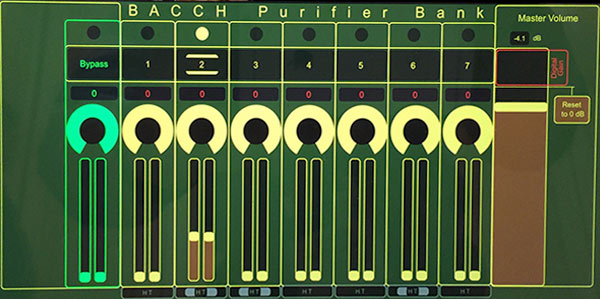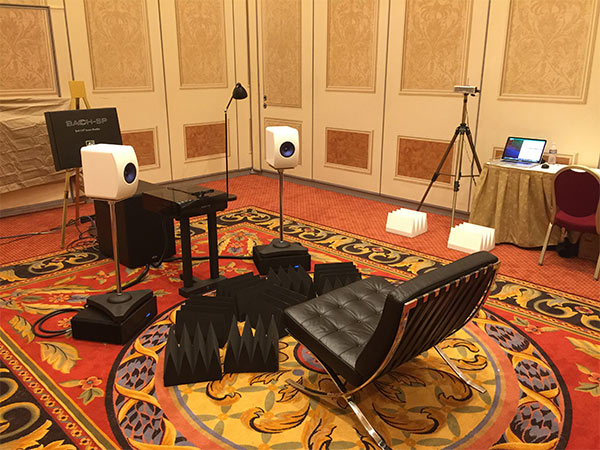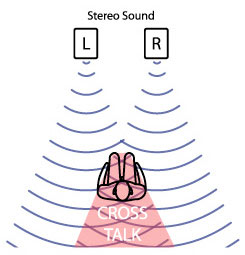3D Audio Follow Up
This is a continuation of the post I started a couple of days ago about the 3D Audio that I experienced in the ballroom next door to the HRA Marketplace at the recent CES 2015 event. You can read the initial installment by clicking here. When I entered the room the setup was as shown in the photograph below:
Figure 1 – The 3D Audio setup prepared by Dr. Edgar Choureiri.
The first thing you notice is the single chair. This is a demonstration for one person in the ideal sweet spot. The two speakers are about 5-6 feet away for the head position of the listener and there is some aggressive baffling on the floor in front of the Barcelona Chair (I guess if you’re going to do a great demo using a classic piece of furniture designed by Mies van der Rohe is a must have rental item).
From a the website I found this statement on the concept behind Dr. Choureiri’s work at Princeton:
“If you ask a room full of people how many have listened to stereo sound through loudspeakers, chances are, everyone will raise their hands. The truth, however, is, that no one has. To faithfully reproduce stereo, the sound source for each channel must be separated. Unfortunately, with conventional two-loudspeakers based audio systems, true stereo cannot be reproduced. Sound from the left speaker ‘spills’ to your right ear and vice versa, resulting in significant crosstalk. On top of that, severe interference and comb-filtering are resulted when the sound from the left speaker meets that from the right speaker. Short of building a wall between the left and right speaker that extends from the front wall all the way to your nose, it seems impossible to avoid this fundamental problem. With crosstalk, your brain is confused by the corruption of information cues, and will not be able to reconstruct stereo images as recorded and intended. Instead of listening to true stereo images, a crosstalk-polluted stereo playback system will only produce phantom images. This fundamental and significant crosstalk problem has plagued two-loudspeakers based stereo playback since day one.”
The following image is included to show the crosstalk created by the two stereo speakers:
Figure 2 – Illustration from the BACCH-SP website showing the crosstalk caused by speakers delivering sound to the wrong ears.
I don’t agree with the statement above. The concept of stereo as first described and implemented by Alan Blumleim in 1931 describes a process of using a pair of microphones (he used omnis at the time but included directional mikes in his patent application) to capture the sound in an acoustic space. The two microphones share many of the same sound sources but have slightly different phase, amplitude, and timbral components. When played back through a pair of headphones (he did refer to his work as “binaural” audio) the idea was to have the listener experience the sound at the location of the stereo pair. This means that the entire panorama of sounds would be audible not merely a center located monophonic reproduction.
When playing back a “true stereo” or Blumlein recording using speakers there will be some crosstalk but no more than would have been in the actual acoustic space. This exclusive separation is only true for binaural stereo…not speaker based reproduction. You can get isolation of left and right by listening to a stereo program on a pair of headphones. I personally don’t particularly like the sound coming from the center of my head. I much prefer to have a pair of stereo speakers reproducing the sound of traditional stereo recording.
The challenge that Dr. Choureiri and others have been dealing with is trying to make binaural recording work outside of headphones, where crosstalk is not a problem, in a pair of loudspeakers. There are plenty of wonderful stereo recordings that present an accurate stereo field without the compromises mentioned in the test above. The real problem with this approach to 3D Audio is that it requires the source recording to be made using a binaural head. And if you think there’s a shortage of real high-resolution audio recordings available, just wait until you try to find binaural recordings at any resolution.
More coming.




Actually, Mark, the Wake Up Your Ears demo collection recorded by David Chesky is composed of 24 bit binaural recordings distributed at 192 and 96Kbps, and sounds very good – and is particularly impressive fed through a DTS Neo matrix surround decoder.
These recordings are apparently recorded using a binaural head located very close to – if not in among – the performers, instead of the “center of the auditorium” approach that has made binaural recordings sound distant and muffled to me until I heard this collection.
The conclusion I drew from hearing the 192Kbps tracks from that demo matrix decoded was that it worked so well – and the 192 sounded clearer than the 96 – because of the two tracks were phase-coherent, not mixed together from mikes at varying distances from the performers. I consider it a sort of “audio holography.”
Ask Dave Chesky for a set of those – they’re periodically made available for purchase for $5 a set, at either resolution, through Audiogon. At that price,I bought both resolutions to see if they sounded different. Since Chesky records digitally, they did.
I guess we’re gonna have to get a bunch of those baffles to carry with us to live performances so we don’t hear that pesky cross-talk. Chair optional.
The engineering rationale sounds virtually the same as that put forth for the Polk Audio “Real Time Array” series speakers from many years ago. The implementation appears very different though.
Correction, that was the “SDA” (Stereo Dimension Array) series. Produced from ’85 to ’91. Found some info at http://www.polksda.com. Nothing new under the sun?
Elimination of crosstalk can produce some physiological nasties. We were happy for ages to call the 8th Cranial Nerve simply “acoustic”. “Vestibulocochlear” better tells its story. Balance and proprioreception are among its duties. We Aussies have a lovely word, “chunder”, to denote a frequent effect of blocking one ear, or sending audio exclusively to one ear. If you intend to listen to a “no crosstalk” recording (itself an audio-engineering artifact) you’d best have a bucket handy.
You are right. He is theoretically full of crap. However, I love full immersion stereo and I won’t judge the Bacch-SP system until I hear it. Just so Dr. Choureiri knows, there is NO sweet spot with a good stereo surround system. Any one in the room can hear sounds in space seemingly emanating from around the room. The data is in the recording. The more tonally balanced the speakers, the better the separation and stability of 3-D image. Of course, that same balance in sonic clarity is required from all of the components in the line between source and listener. I have been experiencing and demonstrating this phenomena since the mid-seventies. Lately, I have discovered records from the late sixties that deliver the goods, as well.
The set-up in the photo looks ridiculous (as do most in the “high-end” audio demo rooms…something done since the mid-seventies). The choice of speakers is suspect. Sadly, most of these university “sound scientists” become the living embodiments of white tower cliches used to describe professors who remain clueless in the real world, thus contributing to the defamation of the over-priced institutions, where they are over-paid and the students are over-charged, receiving poor value for the money invested. Unfortunately, this same description most likely applies to the Bacch-SP system, too. The website is dreadfully designed.
Thank you so much for sharing this information and providing elucidating commentary and photos.
Mark
I am not a technical person or a scientist. Nonethess, I fine your daily blogs interesting, fascinating and very informative. I hope you are able to keep up the good work and not lose heart in your campaigning for honesty and transparency in the hi-rez area of the music business.
John Baxter
Kent
England
Thanks John…it has become a part of my daily tasks and one that I enjoy.
I am now a surround sound snob. Ive got many of my favorite albums now in 5.1 wav and I serve them up through my oppo-103 from my MYCloud external hard drive connected to my home network. I have a 7.1 home theater equipped with high end Klipsch speakers and a Denon receiver. I don’t need video to become immersed in tremendous acoustics in hi-res. Although I have an Epson 3D projector and love the AIX Mozart quartet Blu Ray disk. I think I’d prefer lower res (cd quality minimum) in surround then higher res in stereo.
Nothing snobby about it…surround sound produces a more immersive, more realistic, more entertaining, more emotional music event than the best stereo on the planet. It’s a shame there’s not more of it.
Just saw a response to your post:
http://masisaudio.com/2015/02/05/ces-2015-response-dr-mark-waldreps-3d-audio-follow/
Thanks…it would have been nice of them to let me know. I’ll respond in a future post.
Dr. Waldrep,
We actually intended to let you know of our response, but I guess your reader beat us to it. Anyway, hope our response cleared up some of the confusion. The theory behind BACCH is sound, and as you have experienced it, you know that it works!
Regards, Masis Audio
Thanks for stopping by…and yes, I read your response with interest. I guess my biggest fear is the lack of content prepared specifically in binaural format. Taking normal recordings and playing them through the BACCH system didn’t do much for me…the sound was hollow and unfocused.
It is true that for BACCH to reveal its full potential, it is best to playback Binaural recordings done with a dummy head. I am not sure how much time you spent at CES listening to BACCH, but as someone who has been living with BACCH for some time, I can share my experiences in playing back non-binaural recordings with BACCH.
I would say 99% of the recordings benefit from BACCH. Yes, not all. There are recordings that contain little or no ITD and ILD cues (probably recorded with a bunch of mono microphones). However, the majority of recordings do benefit. You may not get the full immersive result as you do with Binaural recordings, but the ambience retrieval is always much much better. It is all about the spatial realism.
As to your comment about sounding hollow and unfocused, may I suggest to you that it is not ‘correct’ to use a crosstalked playback as your reference. If you could be specific as to which recording you experienced the hollow and unfocused sound, I could perhaps go into greater detail.
The reason for our write up is to point out that the theory behind BACCH is sound. I hope you and your readers will take time to read our reply. Prof. Choueiri’s white paper is also available for the technically inclined readers.
I went in with Edgar and experienced the main system for about 10 minutes and was impressed. It’s not a sound or spatial reality that I like…things are too distant. I’m not interested in listening to a sonic documentary…but I certainly can acknowledge the lvel to which the crosstalk and system are performing. The idea of spatial realism is not my own focus.
I also visited the room during the show and listened to Dark Side of the Moon on the smaller system. It simply didn’t sound like a commercial rock recording should…and I’ve spent a lifetime listening and engineering records of that sort.
I’m always interested in unconventional ideas even if they don’t achieve their intended goal or don’t work at all. I’m interested in the analytic thought process behind them to see if there is anything I can learn from them and also to see what my competitors are up to. I’m not into tweaks touted as breakthroughs or other subtle improvements. I view recreation of sound as it would have been heard live, documentary sound as an intellectual challenge, not a passion. A puzzle to be understood and solved.
Crosstalk or cross channel phase cancellation to create or improve channel separation in stereo is not a new idea. It goes back to at least the Zenith FM stereo multiplexing compatible system adopted by the FCC around 1960 as the standard for stereo FM broadcasts in the US. In this system an L-R channel is frequency shifted to beyond 20 kHz to modulate the carrier. It is detected and separated at the receiver and added in phase and out of phase to the L+R conventional FM signal to derive the L and R channels. The concept was adapted by Ralph Glasgal in his patented stereo separation control assigned to Fisher Radio Corporation in the 1980s. It appears that a variant of this circuit is used in every HT receiver for the “wide” mode. Glasgal applied this principle to acoustic fields to replace his separation wall in his Ambiophonic system. Contending with this concept with acoustic fields is trickier and presents additional problems. These relate primarily to the relatively slow speed of sound and path length differences between the left and right speaker to each ear. So to optimize the effect, the out of phase signal from the opposite channel must be delayed in time and attenuated by just the right amount when applied to the opposite speaker so that the sound wave from one channel will arrive at the precisely the same time and loudness out of phase with the opposite channel. It’s a miracle that it works at all but it can be made to work within limits. One limit is that the scheme only works in a limited region of space and as frequencies get higher and wavelengths shorter, this region diminishes to the point where it disappears altogether. Choueiri’s variant uses a filter to compensate for a tonal imbalance this creates. Another problem for all such systems is that unwanted reflections degrade the effect. They must therefore be reduced to an absolute minimum.
Glassgal’s concept is similar with important differences. He uses a recursive delay circuit but would not or could not tell me why. But he said it was necessary. He also has his two main speakers he calls ambiopoles close together, about 20 degrees apart. At 55 degrees which he claims is a critical angle he has additional speakers with longer time delays in milliseconds not microseconds. He also has installed a surround system consisting of a virtual 360 degree wall of Soundlabs electrostatic panels and commercial reverberation units. He’s added two more ambiopoles behind the listener. His huge room about 30′ x 40′ x 40′ high is covered with Armstrong Soundsoak. These are fiberglass panels covered in cloth. I heard this setup twice with the same reaction which was interesting.
Sound sources seemed to be spread out along a line between me and the speakers at about a 150 degree horizontal angle. Their location was so specific I felt I could almost reach out and touch them. The electrostatic panels, the main ones being almost 8′ tall and curved were remarkably clear sounding although I would not call it anymore accurate than other speakers. I judged the surround reverberant sound system adjunct that was supposed to create a sense of space and envelopment as entirely ineffective.
I applaud the few intrepid people who think up these original ideas and try them out. They are the ones doing the real thinking even where they fail. In the case of 3D Sound and Ambiophonic sound IMO they both fail although I haven’t heard 3 D sound. One fundamental mistake they make is that they do not take into account the vector nature of sound fields. Like most other schemes, this is a fatal error which means they can never be made to work even if they produce interesting effects.